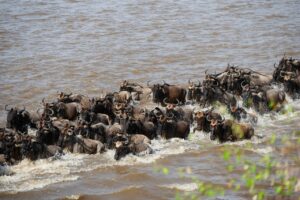Intro: The Wild Meets Comfort
If you’ve ever dreamed of waking up to the sound of lions in the distance or watching elephants wander past your veranda, staying in a safari lodge or tented camp might be exactly what you’re looking for. But what’s it actually like? Do you have to rough it? Is it safe? Can a tent really be luxurious?
Let’s walk through the experience, from check-in to stargazing.
1. Lodges vs. Tented Camps – What’s the Difference?
-
Safari Lodges: Think of these like small boutique hotels, but set deep in the bush. They have solid walls, en-suite bathrooms, and often even pools, spas, and gourmet dining
-
Tented Camps: These range from rustic (bucket showers and lanterns) to ultra-luxury (hardwood floors, king-size beds, clawfoot tubs). Yes, they’re tents – but not the kind you take camping.
👉 Both offer unforgettable immersion into the wild — the choice depends on your comfort level and budget.
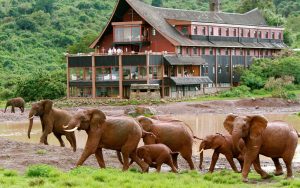
2. The Arrival – Warm Welcomes and Wild Views
You’re often greeted with a cool towel and a welcome drink. Staff members know your name and treat you like royalty. The lodge or camp typically blends into its surroundings — expect wood, stone, and canvas architecture designed to let the landscape shine.
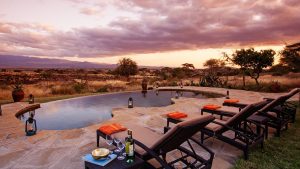
3. The Rooms – Not Your Average Tent
Whether in a lodge suite or tented room, you’ll usually find:
-
Comfy beds with mosquito nets
-
Private bathrooms (yes, flush toilets!)
-
A deck or patio with a front-row seat to wildlife
Some camps even offer outdoor showers — surreal when elephants wander nearby while you shampoo.

4. Safety – You’re Not Alone Out There
Animals are wild and the camp is unfenced — but that’s part of the magic. Guides escort you at night, and you’re always briefed on safety protocols. Staff are trained to deal with wildlife, and you’ll quickly learn to respect (and not fear) the bush.
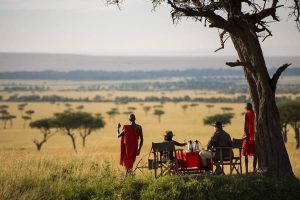
5. Dining – Bush Cuisine With a View
Meals are a highlight. Think three-course dinners under the stars, bush breakfasts after a morning game drive, and sundowners with giraffes on the horizon. Many camps accommodate dietary preferences — just let them know in advance.
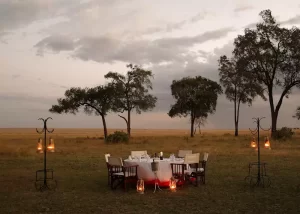
6. The Sounds – Nature’s Playlist
You’ll hear things at night. Lions roaring, hyenas cackling, and the occasional elephant munching nearby. It’s surreal, humbling, and unforgettable. Earplugs? Optional, but you probably won’t want them.
7. Is It Worth It?
Absolutely. Staying in a safari lodge or tented camp offers a once-in-a-lifetime blend of adventure and comfort. It’s not just about seeing wildlife — it’s about living in their world, if only for a few nights.
Final Thoughts
Whether you’re glamping in a tent with chandeliers or sipping tea on a lodge deck as zebras stroll by, this kind of stay redefines what it means to “go on safari.” It’s magical, grounding, and deeply moving — and once you’ve experienced it, regular hotels will never quite feel the same.
Private Safari vs. Group Safari: Key Differences
1. Privacy & Flexibility
-
Private Safari:
You choose who you travel with—whether it’s just you, your partner, or your own group. You get full control over the schedule, stops, and how long you stay at each wildlife sighting.
Perfect if you want a tailored experience. -
Group Safari:
You’re traveling with others (usually 1 – 7 people). The itinerary is fixed and shared. Great for social travelers or those on a tighter budget. 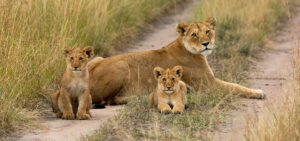
2. Cost
-
-
Private Safari:
Usually more expensive, especially for solo travelers or couples, since you’re covering the cost of the guide, vehicle, and logistics on your own.
But it can be cost-effective for groups of 3 or more. -
Group Safari:
More affordable, since the cost is split among everyone.
Ideal for backpackers, students, or travelers looking to keep things budget-friendly
-
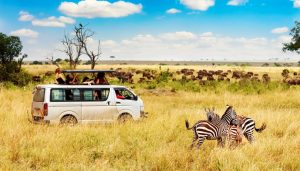
-
3. Experience & Customization
-
Private Safari:
You can fully customize your itinerary—focus on birds, photography, specific animals, or even off-the-beaten-path parks.
Great for photographers, families with kids, or honeymooners. -
Group Safari:
The route, stops, and game drives are fixed. There’s less flexibility to change things up mid-way.
It’s more about enjoying a well-planned
4. Social Dynamics
-
Private Safari:
You’re with your own people. Quieter, more intimate, and often more relaxed.
Good if you’re looking for peace or a romantic vibe. -
Group Safari:
You’ll meet new people from around the world, share stories, and maybe make lifelong friends.
Fun for solo travelers and extroverts.
5. Vehicle Type
-
Private:
Usually a 4×4 Land Cruiser with pop-up roof, fully at your disposal. -
Group:Similar vehicle, but shared with others, and you might rotate seats during the trip.
-

-
🌍 So, Which One Is Right for You?
-
Choose a Private Safari if…
-
You want full control and privacy
-
You’re traveling as a family, couple, or photographer
-
You’re okay spending more for a premium, personalized experience
-
-
Choose a Group Safari if…
-
You’re traveling solo or on a budget
-
You enjoy socializing and meeting new people
-
You’re okay with a set itinerary
🙋♂️ Final Thoughts: Ask Yourself These 3 Questions
-
Do I value flexibility or saving money more?
-
Am I comfortable sharing space with strangers?
-
How important is a personalized experience for me?
-
-
-
-
-
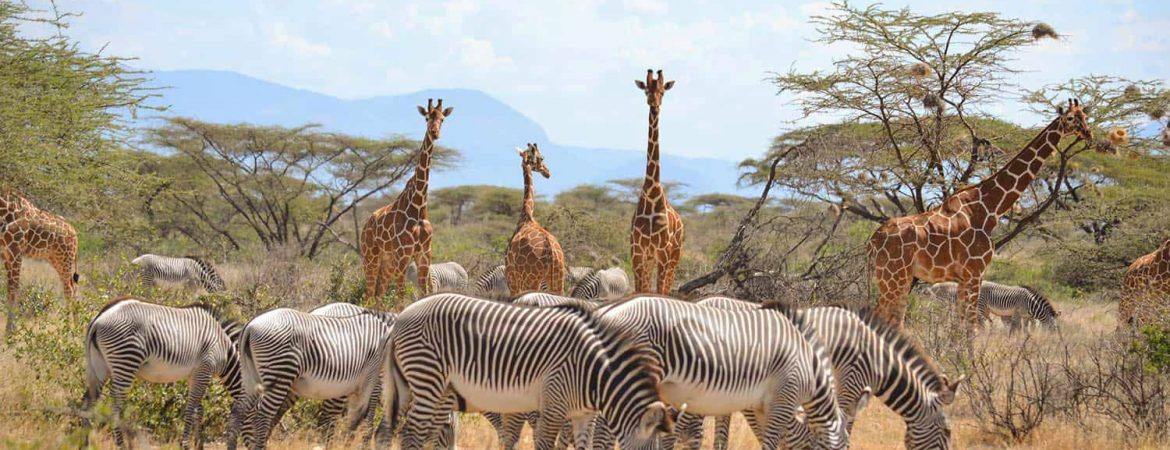
Far from the bustling crowds of Kenya’s southern safari circuit lies a land that feels almost untouched—a place of dramatic landscapes, red earth, and quiet mystery. This is Samburu, a semi-arid region in northern Kenya where wildlife has evolved in unique ways to survive and thrive. Here, the classic “Big Five” take a step back, and a new group of stars emerges.
Known as the Samburu Special Five, these animals are rare, region-specific, and a must-see for any wildlife lover or conservation enthusiast. So, what makes them so special? Each species in the Samburu Special Five is uniquely adapted to this dry and rugged terrain. Some are endangered, others rarely seen outside this region, and all are stunning examples of evolutionary artistry. Let’s meet them:
🦒 1. Reticulated Giraffe
One of the most striking giraffes in the world, the reticulated giraffe is named for its beautiful coat—deep orange patches outlined with crisp white lines, creating a perfect net-like pattern. Unlike its cousins in the south, this giraffe is found primarily in northern Kenya and parts of Somalia. Despite its grace and beauty, the reticulated giraffe is vulnerable, with populations declining due to habitat loss and poaching. In Samburu, though, they’re a common and magical sight, often gliding across the open plains in small family groups.
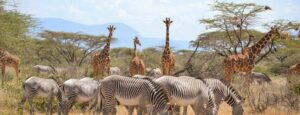
🦓 2. Grevy’s Zebra
The Grevy’s zebra is the largest and most endangered of all zebra species. With narrower stripes, larger ears, and a white belly, it stands apart from the more common plains zebra. Grevy’s zebras are also known for their independence—they often live solitary lives or in small groups, unlike their more social relatives. Less than 3,000 remain in the wild, making Samburu one of the last strongholds for this extraordinary species.
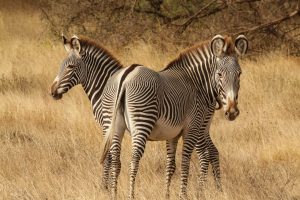
3. Gerenuk
Delicate, strange, and unforgettable, the gerenuk—often called the “giraffe gazelle”—is a long-necked antelope that stands upright on its hind legs to browse leaves from tall shrubs. With its slim frame, large eyes, and curious feeding style, it looks almost alien at first glance. Gerenuks are shy and elusive, often seen alone or in small groups, blending easily into Samburu’s dry bushland.
4. Beisa Oryx
The Beisa oryx is a desert antelope built for survival. With long, spear-like horns, a strong body, and facial markings that resemble war paint, it’s both beautiful and battle-ready. These animals can survive in extreme heat with very little water—an incredible adaptation to the arid Samburu landscape. Their stoic presence and striking look give them an almost mythical air.
5. Somali Ostrich
Last but not least, the Somali ostrich—a bold and majestic bird, distinguished by its grey-blue neck and legs. Larger than the common ostrich, this bird is powerful, fast, and uniquely adapted to the northern Kenyan ecosystem. Though flightless, the Somali ostrich is far from helpless. It can sprint at incredible speeds and defend itself with powerful kicks. In the open scrub of Samburu, it’s both a sentinel and a symbol of strength.
Conclusion: More Than Just Wildlife
The Samburu Special Five are more than rare animals, they’re symbols of a wild, beautiful ecosystem that’s often overlooked. They remind us that nature holds endless diversity beyond the spotlight. And that sometimes, the most powerful stories are whispered in the quiet corners of the world.
As we begin this journey into their lives, habits, and habitats, may it open your eyes to the unique magic of northern Kenya and the importance of protecting it.
Whether you’re a wildlife enthusiast, a curious traveler, or someone who simply loves a good story from the wild, there’s something in Samburu for you.
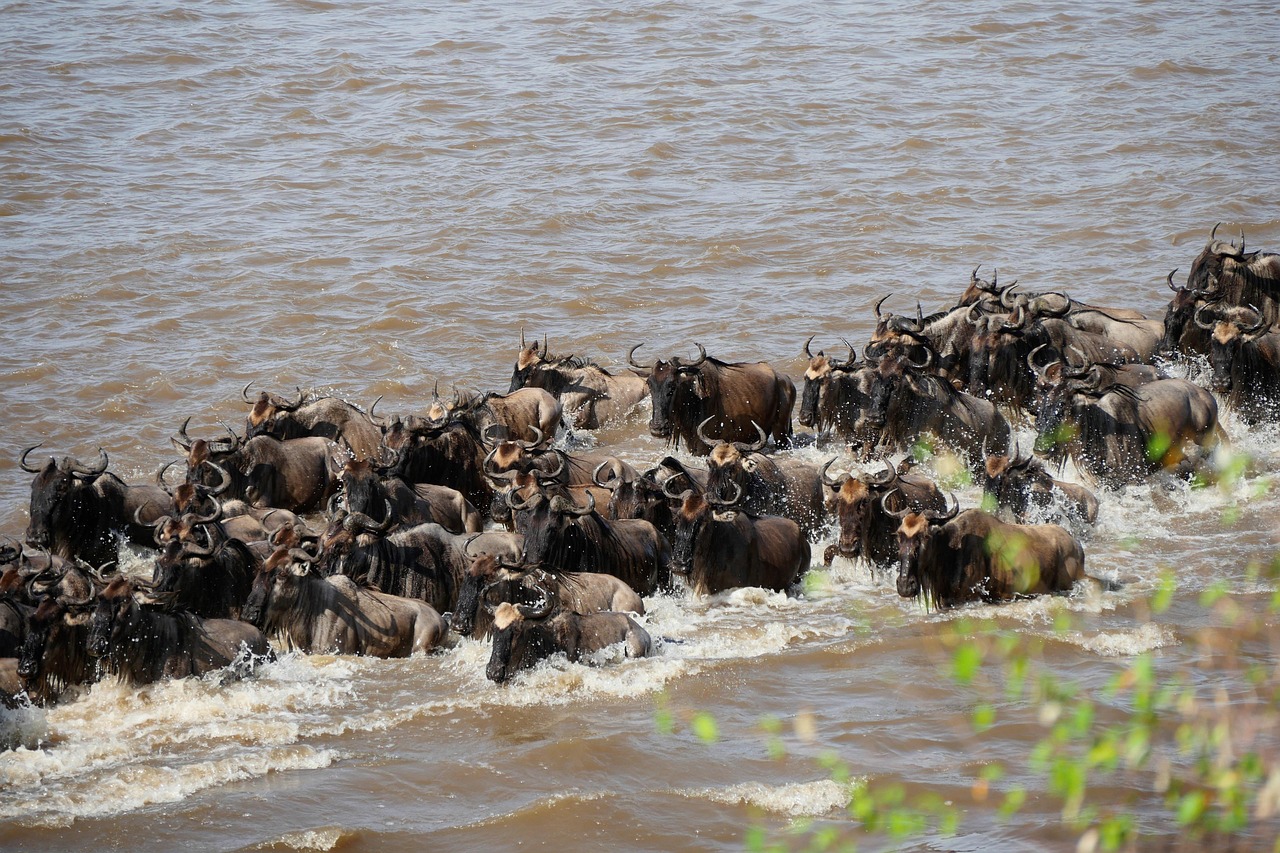
The Maasai Mara: Why It’s the Heart of Kenya’s Safari Scene
The Maasai Mara National Reserve is undoubtedly one of Kenya’s most iconic safari destinations, and for good reason. With its breathtaking landscapes, rich biodiversity, and historical significance, the Mara truly earns its place as the heart of Kenya’s safari scene. Here’s why:
1. The Great Migration: A Natural Spectacle
Every year, the Maasai Mara plays host to one of the most awe-inspiring natural events on the planet: the Great Migration. Over 1.5 million wildebeest, along with hundreds of thousands of zebras and gazelles, trek from the Serengeti in Tanzania to the Mara in search of fresh grazing lands. This incredible migration attracts predators, like lions, cheetahs, and crocodiles, creating a dramatic spectacle that captivates travelers from all over the world.
2. The Big Five in Abundance
The Maasai Mara is one of the best places to see Africa’s “Big Five”—lions, leopards, elephants, buffaloes, and rhinos—up close and personal. Lions roam freely across the savannah, and the Mara’s leopard population is one of the highest in Africa. Elephants and buffaloes graze the vast plains, while rhinos can be spotted in the reserve’s protected areas. The chance to witness these iconic animals in their natural habitat is a highlight of any safari experience.
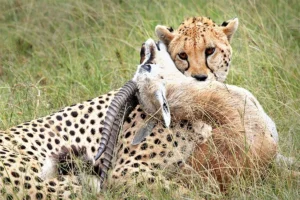
3. Diverse Wildlife and Unique Species
Aside from the Big Five, the Maasai Mara is home to a stunning variety of wildlife. From the graceful giraffes and playful cheetahs to the elusive serval and the rare African wild dog, the reserve offers some of the best opportunities for wildlife photography and observation. Birdwatchers will also be thrilled by the over 500 bird species that call the Mara home, including the colorful lilac-breasted roller and the majestic ostrich.
4. Vibrant Maasai Culture
The Maasai Mara is located in the heart of Maasai land, and the Maasai people’s presence adds a unique cultural dimension to your safari experience. Visitors have the opportunity to learn about Maasai traditions, lifestyle, and their deep connection to the land. The Maasai are known for their distinctive clothing and beadwork, and many tours include a visit to a Maasai village, where you can experience their dances, songs, and customs firsthand.
5. Stunning Landscapes
The Maasai Mara’s landscapes are nothing short of spectacular. From the vast, golden plains to the rugged hills, the reserve’s ever-changing scenery provides a stunning backdrop for your safari adventure. Whether you’re watching a predator stalking its prey or witnessing a dramatic sunset, the beauty of the Mara enhances every moment. The reserve’s rolling hills and acacia trees are especially photogenic during the golden hour, offering fantastic opportunities for photography.
6. Exclusive Safari Experience
The Maasai Mara offers both luxury and more budget-friendly safari experiences. From high-end lodges and private game reserves to affordable campsites, there’s something for everyone. The park’s diverse accommodations ensure that you can enjoy the Mara’s splendor in comfort and style, whether you prefer staying in a luxurious tented camp or a boutique lodge with panoramic views of the plains.
7. Unforgettable Safari Activities
Beyond traditional game drives, the Maasai Mara offers several unique activities that make your visit even more memorable. A hot air balloon safari at sunrise provides a bird’s-eye view of the Mara’s vast landscapes and wildlife, while walking safaris with an experienced guide offer a more intimate and educational encounter with nature. For those seeking a touch of adventure, a river crossing or a bush breakfast in the wilderness adds an extra thrill to the experience.
8. Year-Round Wildlife Viewing
Unlike some other safari destinations that have specific peak seasons, the Maasai Mara offers fantastic wildlife viewing year-round. While the Great Migration is a highlight, the reserve’s wildlife is abundant throughout the year. Whether you’re visiting during the dry season, when animals gather around waterholes, or the wet season, when the Mara’s landscapes are lush and green, there’s always something extraordinary to see.
Conclusion
The Maasai Mara is not just a destination; it’s an experience that captures the essence of Africa’s wild beauty. Whether you’re witnessing the Great Migration, tracking the Big Five, or learning about Maasai culture, the Mara offers a safari experience like no other. Its stunning landscapes, diverse wildlife, and rich heritage make it the undeniable heart of Kenya’s safari scene, drawing travelers from across the globe to witness its wonders. If you’re planning a Kenyan safari, a visit to the Maasai Mara should undoubtedly be at the top of your list.
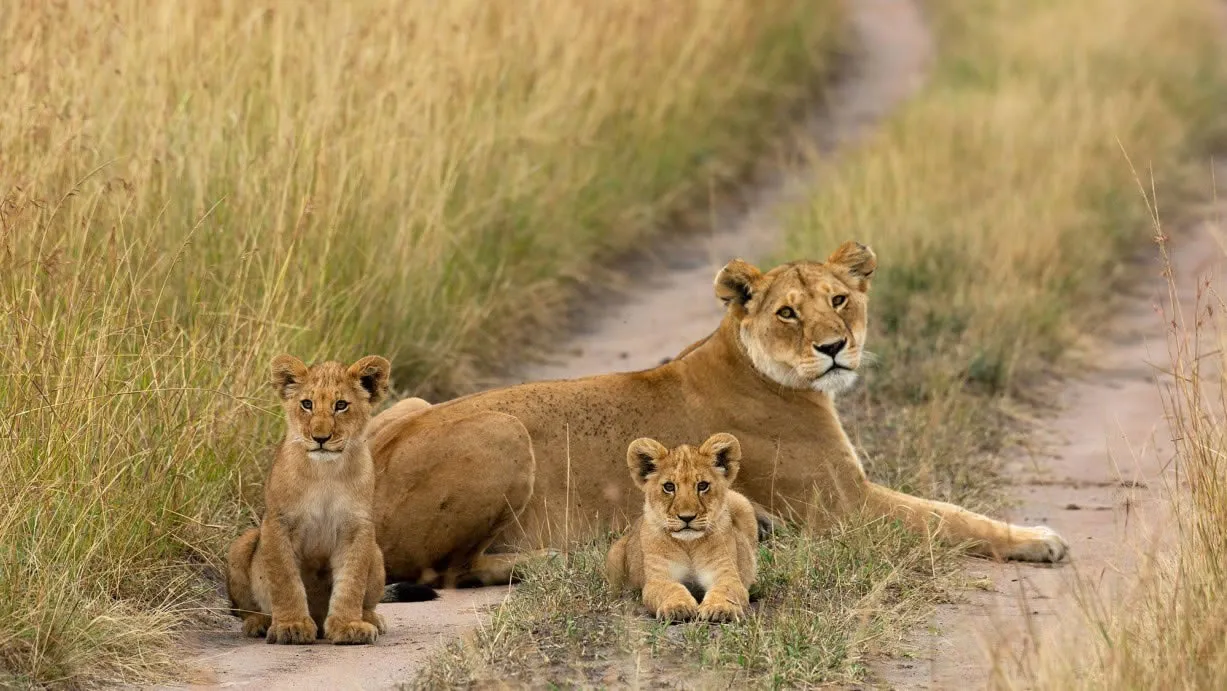
Introduction:
When it comes to Africa’s wildlife, the term “Big Five” refers to five of the continent’s most iconic and sought-after animals to spot on a safari. These animals are celebrated not only for their impressive size but also for their majestic presence in the wild. Masai Mara, one of the most famous and biodiverse game reserves in Kenya, is a prime destination to experience these creatures up close. In this guide, we’ll explore each of the Big Five animals and provide tips on how to spot them while visiting the Masai Mara.
1. The Lion: King of the Jungle
Why Lions Are Special in Masai Mara
Lions are one of the most iconic symbols of African wildlife. In Masai Mara, they are a central part of the ecosystem and can often be seen in prides, with males dominating their territories and females doing the majority of the hunting. Known as the “King of the Jungle,” lions in Masai Mara roam freely across the open plains, especially near riverbeds and tall grasslands.
Where to Spot Lions
Lions in Masai Mara are often spotted during early morning or late evening game drives. Look for them lounging under acacia trees or on the rocky outcrops where they can keep an eye on their surroundings. The Mara Triangle is particularly known for having large prides.
Fun Fact
Masai Mara lions are known for their impressive manes, which are darker and fuller than those found in other regions of Africa.
2. The Leopard: Stealthy and Elusive
Why Leopards Are Fascinating
Leopards are notorious for their elusive and solitary nature. Unlike lions, which are social animals, leopards prefer to live alone. They are excellent climbers and often drag their prey up into trees to keep it safe from scavengers like hyenas.
Where to Spot Leopards
Leopards are tricky to spot due to their camouflaged fur, which blends in with the tree branches and tall grass. Look for them in tree canopies or along the Mara River’s edge, where they often hide in the thick foliage. Your best chance to spot a leopard is during early mornings or late afternoons when they are most active.
Fun Fact
Leopards have an extraordinary ability to carry prey up into trees, sometimes even larger prey, such as impalas or wildebeest calves, with ease.
3. The Elephant: Majestic Giants
Why Elephants Are Awe-Inspiring
The African elephant is the largest land mammal on Earth and a major draw for safari-goers. Masai Mara is home to large herds of elephants that roam the reserve’s vast plains and forests. These intelligent and social creatures form strong family bonds and are often seen with their young, displaying impressive maternal care.
Where to Spot Elephants
Elephants are commonly spotted throughout the Masai Mara, particularly near water sources such as the Mara River, where they come to drink and bathe. The Talek River and the conservation areas surrounding the park are also great spots to see these gentle giants.
Fun Fact
Elephants have remarkable memories and can recognize individual humans and other elephants they’ve encountered in the past.
4. The Rhinoceros: The Gentle Giants of the Wild
Why Rhinos Are Unique
Rhinos are some of the most endangered animals in the world, and Masai Mara is one of the few places where you can still spot both black and white rhinos. While white rhinos are more common in the open plains, black rhinos tend to favor the dense bush and acacia forests. Both species are critically endangered, so sightings are considered a rare treat.
Where to Spot Rhinos
Rhinos are often found in Masai Mara’s conservation areas, especially in the southern parts of the reserve, where efforts have been focused on their protection. The Mara Conservancies, such as the Olare Motorogi Conservancy, are also good areas to look for them.
Fun Fact
Despite their large size and thick skin, rhinos are incredibly agile and can run up to 30 miles per hour (48 km/h) for short distances when they feel threatened.
5. The Buffalo: Powerful and Unyielding
Why Buffalos Are Impressive
The African buffalo is one of the most powerful animals in Africa. Unlike other members of the Big Five, buffaloes are known for their unpredictable nature. They form large herds for protection and are often seen grazing on the open plains or near water sources. Their horns are massive and thick, making them formidable opponents.
Where to Spot Buffalos
Buffaloes can be found in large herds throughout Masai Mara. The riverbanks, especially the Mara River, are great spots to see these animals as they often come to drink or wallow in the mud. The open savannah is also a prime location for spotting them.
Fun Fact
Buffalos are known for their strong herd structure. They are one of the few species that will fight back in unison against predators like lions and hyenas, especially when calves are threatened.
Conclusion: The Big Five Experience in Masai Mara
Masai Mara is an incredible destination for those wishing to see the Big Five in their natural habitat. With its stunning landscapes and rich biodiversity, it offers visitors an unparalleled opportunity to observe these majestic creatures in the wild. Whether you’re embarking on a thrilling game drive or a peaceful hot air balloon ride over the savannah, the Masai Mara Big Five are sure to leave you with memories that last a lifetime. Remember to bring your camera, stay respectful of the wildlife, and enjoy the experience of witnessing nature’s most iconic animals up close
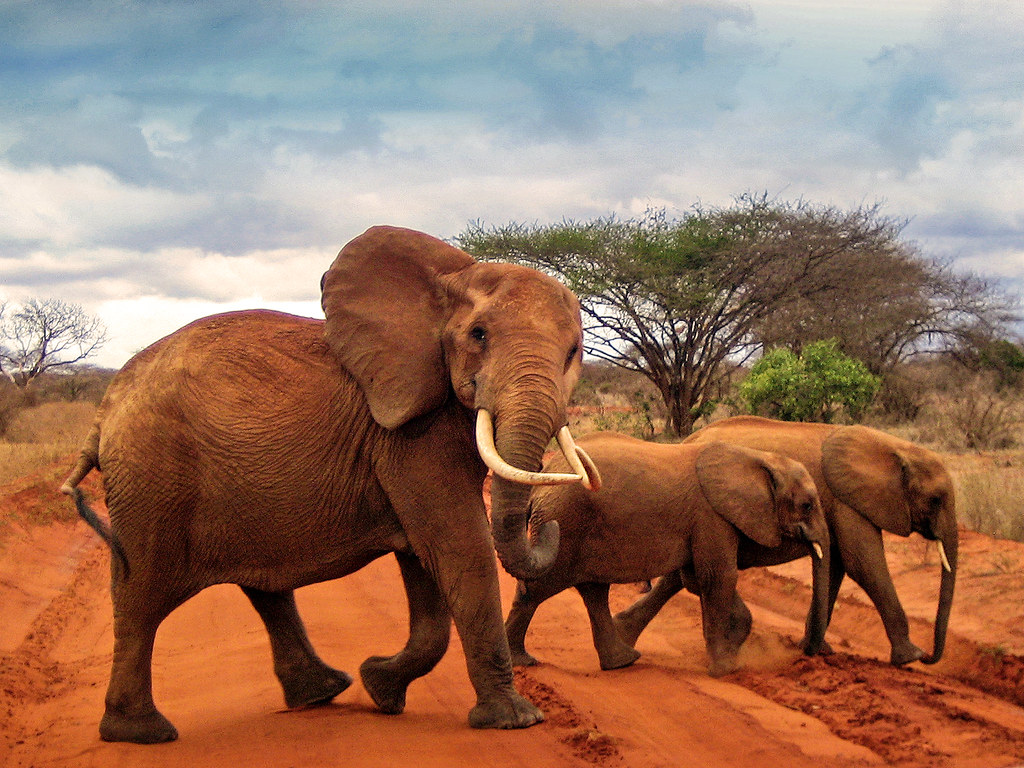
If you’re dreaming of an unforgettable safari adventure, you may be wondering which destination is best for your wildlife adventure: Kenya or Tanzania? Both countries offer extraordinary experiences in the heart of East Africa, but there are key differences that can help you choose the perfect safari for you. Let’s dive into the main contrasts between these two incredible safari destinations. (more…)

